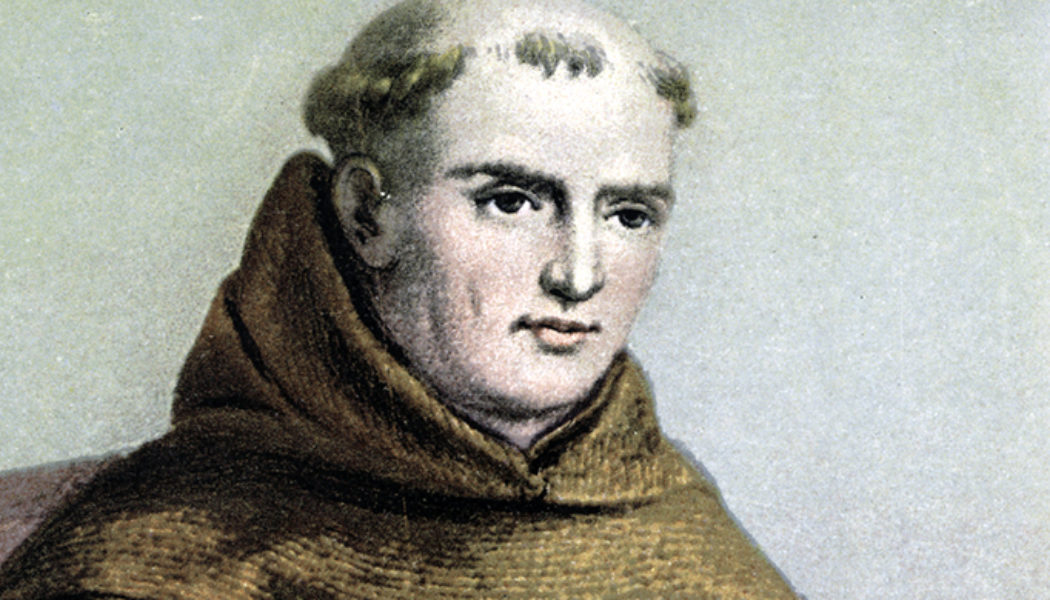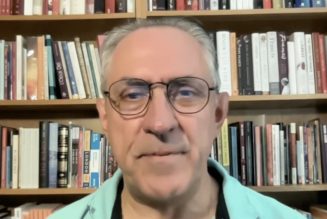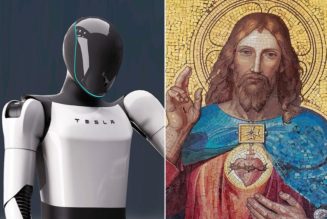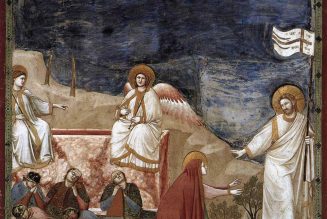
St. Junipero Serra (1713-84) is a significant name in California’s history. Revered by some, reviled by others, the dedicated Franciscan friar launched California’s mission system in 1769, and would ultimately oversee the founding of the State’s first nine missions. Twenty-one missions would be founded by the Spanish in all.
Serra was born in the island of Majorca, a Spanish island possession off the eastern coast of Spain, and joined the Franciscan order at age 17. He quickly distinguished himself for both his piety and learning, and spent more than a decade preaching and teaching at the university level in Majorca. Inspired by the example of the great missionaries of his order, he sailed for Mexico on 1749. He spent the remainder of his life evangelizing the Indians of Mexico and California.
At age 56, he began his apostolic missionary work in California; his goal was to bring the Catholic faith to the Indians and make them citizens of New Spain. His missionaries also brought with them the crops and livestock which would make California prosper.
Pope John Paul II, believing Serra lived a life of virtue and is a role model for Catholics, declared him venerable in 1985. In 1988, the pontiff accepted that a miracle had been worked through Serra’s intercession and beatified him. In 2015, Pope Francis canonized him at the Basilica of the National Shrine of the Immaculate Conception in Washington, D.C.
Serra’s contribution to California has been recognized by civil authorities as well. In 1931, a statue of Serra was unveiled in the U.S. Capitol. The following are comments on the life of St. Junipero Serra, offered by individuals who have studied the life of the venerable padre extensively.
Andy Galvan is curator of Mission Dolores in San Francisco. He is a former Franciscan brother, and his ancestors include the Ohlone Indians (the inhabitants of the San Francisco Bay area before the arrival of the Spanish). He also served as a member of the board of directors of the Junipero Serra Cause for Canonization. Although some who identify themselves as descendants of the California Indians have criticized Serra for his treatment of the Indians, Galvan has a different perspective. He said, “I believe Serra is a saint.”
Galvan was active in the support of Serra’s cause for canonization beginning in 1978, when he met Serra biographer and Franciscan friar Fr. Noel Francis Moholy (1916-98) at Mission San Jose. Fr. Moholy devoted over 40 years of his life to seeing Serra canonized as vice postulator of Serra’s cause, and stood with Galvan at the Vatican to see Serra beatified. Although Fr. Moholy died before Fr. Serra was declared a saint, Galvan was excited to see it himself.
Galvan described Serra as a hard worker, “all wood and nails.” Examination of his skeletal remains and written accounts indicate that he was 5-foot, 2-inches tall, had blue eyes and a dark complexion. But, most notably, “Serra was on fire for spreading the Gospel message.”
In studying the friar, however, it is important to remember that his was a perspective of a man of the 18th century, different from that of many people today, Galvan said.
As a teenager, Galvan continued, Serra was inspired by the example of the Spanish Franciscan St. Francis Solano (1549-1610), who came to present-day South America to preach the Gospel to its inhabitants. He also stressed that Serra was heavily influenced by the teachings of philosopher-theologian Blessed John Duns Scotus (1266-1308).
Galvan remarked, “It became Serra’s life dream to preach the Gospel in a place where it had never been brought before.”
Msgr. Francis Weber of Mission San Fernando is a priest and archivist emeritus for the Archdiocese of Los Angeles. He has written “seven or eight” books on Serra, including Life and Times of Fray Junipero Serra in 1987. He said, “Serra is one of the great heroes of California, and a great exemplar for young people. He was an outstanding person.”
One of Serra’s most notable qualities, said Msgr. Weber, was curiosity, which “impelled him to do all kinds of things.” He was curious about the lives of the California Indians, for example.
Monsignor is a seasoned historian, and he encourages those who want to learn about Serra to begin by reading the ample writings of Serra himself, and historical accounts written about Serra by those who knew him. Monsignor recommended the work of Franciscan priest and historian Maynard Geiger (1901-77), a defender of the California mission system, whose works include books on Serra himself and compilations of Serra’s letters.
Msgr. Weber continued, “Historians are literary detectives. They need to examine the evidence presented by people who lived in the time [of people such as Serra]. Also, we must remember not to judge a person by our standards, but by the standards of the time in which they lived.”
Serra and many of his fellow missionaries were university professors, Msgr. Weber continued, who left the comforts of home to bring the Catholic faith and “what they considered a better way of life to the aboriginal people of California.” Monsignor continued, “The Native Americans had no formal education, and the missionaries’ idea was to bring them to the missions, [introduce them to] agriculture and raise cattle and other livestock.”
Relative to today, there were few people in California and wild game plentiful, Msgr. Weber said. But, he added, “If you’d kill a beast you’d have to eat it that day, as you’d have nothing to refrigerate it with. They didn’t have what we’d consider the necessities of modern life.”
It was the idea of the Spanish, he said, to elevate the life of the California Indians: “They thought, ‘Our society offers a better way to live life out.’”
Msgr. Weber rejected the belief of some that Serra had mistreated the Indians: “There’s no single recorded example in the official documentation of the period that Serra mistreated the Native Americans … in fact, he walked all the way to Mexico City to get a bill of rights issued for them. He was a great man all around.”
Bob Spidell has served as a docent at Mission San Juan Capistrano. He is past president of the docent society, and has done an extensive study of Serra.
Spidell, who is not Catholic, described Serra as a man “extremely dedicated to the Catholic Church. Everything he did, from the time he was a boy, was to promote the Catholic Church.”
He continued, “Serra was always looking to expand the Church. He asked his superiors for permission to found a mission, they’d say no, and he’d do it anyway.”
He was an able leader, Spidell said, and effective at defending his actions to his superiors. Spidell remarked, “He had to travel to Mexico several times to do this, and he was good at it.”
Serra’s determination led him to overcome many challenges. When he first arrived in Vera Cruz, Mexico, he was bitten by a bug. The wound never properly healed, and it caused him much suffering the rest of his life. Shortly before his death, Serra walked from Carmel to Mission San Gabriel (in the Los Angeles area), virtually not eating for 18 days. Spidell said, “He did this on sheer will power.”
Serra’s contribution to California was enormous, Spidell believes: “Without someone like him, California would be a much different place. It’s not clear that Spain would have expanded into California at all.”
Spidell, too, said there was nothing in historical documents to indicate that Serra had mistreated the Indians; in fact, “he was protective of the Indians, such as when the Spanish soldiers were cruel to them. He looked after them as part of his flock.”
Spidell added that considering one culture had completely dominated another, he was “surprised there wasn’t more friction between them.” The Spanish converted the Indians from hunter-gatherers to farmers and ranchers, he said, which allowed for a much more stable food supply. Spidell quipped, “The Spanish had a good business model. If you join our church, we’ll feed and clothe you.”
Kristina Foss is museum director of Old Mission Santa Barbara, Vice Chair of the California Missions Foundation, has taught Native American Studies at Santa Barbara City College for 40 years and is a descendant of the Muscogee Indians.
She recently traveled to Serra’s birthplace, Majorca, and visited sites of historical significance in Serra’s life. “As a native person” she went with some negative attitudes about Serra and the missions, but came home from Majorca “with a different take than I thought I would.”
She saw Serra as a classroom philosophy professor, influenced by the writings of Scotus, wanting to establish “a perfect Christian community, in which everyone would share, there would be no fighting and everyone would be kind to and love each other.”
He thought such a community could not be achieved in Europe, she said, but the Indians “free from his cultural trappings” could. She continued, “I saw Serra from his time period. He was trying to come to the New World to bring what he believed was cultural and social Christian improvement, not merely establishing the political policies of Spain.”
She discovered that the homes in Indian villages built in Santa Barbara were modeled after Serra’s own boyhood home in Majorca. She continued, “He thought he was bringing social change that would be beneficial to California. He went up in my estimation.”
What is considered mistreatment today—such as corporal punishment—was commonplace in Europe at the time, she added, and was not considered mistreatment. Some of the harm that came to the California Indians, such as diseases brought by the Spanish or illnesses caused by the introduction of a new diet, was not intended by the padres and “I think was a cause of sorrow to Serra.”
She believes it is fitting to celebrate Serra’s life, because “whatever your political view, Serra is incredibly important in what happened to California.”
Bob Senkewicz, a professor of history at Santa Clara University who wrote a book on Serra, agreed that Serra “is one of the most important figures in California history before the Gold Rush.”
Serra is also a symbol of what California has become, he said. He explained, “California is a place where people of different points of view come together, sometimes amicably, sometimes filled with tension. I think California is still that way today.”
Serra was not an American but a Latin American missionary, he added, in a long-established mission system: “He was extremely committed to his mission of evangelizing non-Christians. He was trying to save people’s souls.”
Jim Graves was a volunteer docent at Mission San Juan Capistrano, Orange County, California’s only mission, for three years. During that time, he shared the story of St. Junipero Serra and the missions with many school children.
This article originally appeared July 1, 2017, at the Register.
Join Our Telegram Group : Salvation & Prosperity








